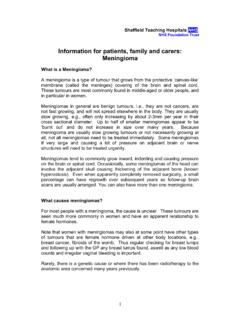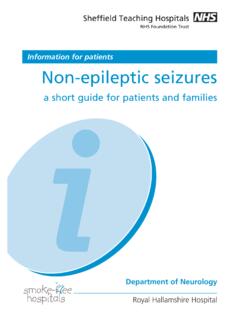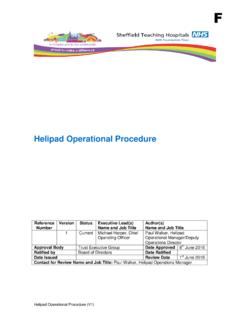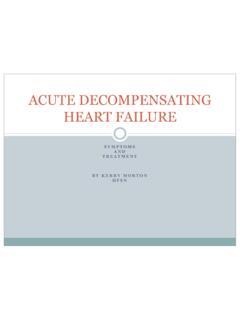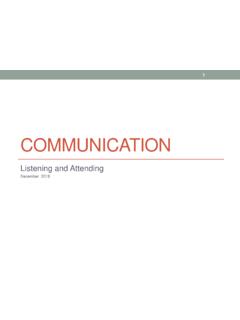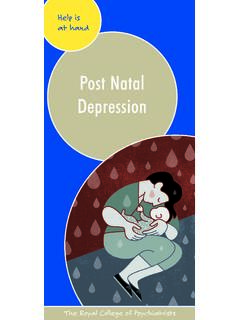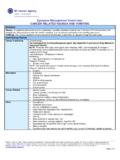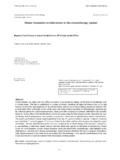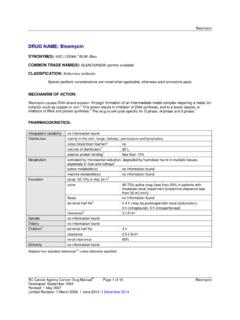Transcription of Vomits, Constipation and Bowel Obstruction
1 Vomits, Constipation and Bowel Obstruction Dr James Davies Palliative Medicine Consultant September 2019 Objectives Assessment of vomiting Managing vomiting Constipation Bowel Obstruction Some terms nausea and vomiting are distinct entities nausea the subjective feeling of the need to vomit or retch Vomiting (emesis) oral expulsion of GI contents (active) Regurgitation effortless passage of gastric contents into the mouth Retching muscular events of vomiting without the expulsion of vomitus Dyspepsia epigastric burning, gnawing, bloating, pain Case study 42 year old man Diagnosed with oesophageal cancer 4 months ago Started on oxycodone last week due to epigastric pain Presents with vomiting Initial thoughts?
2 S out of his mouth O very suddenly after lunch on Sunday C undigested food R no diarrhoea A pain got worse after eating T now after eating anything or drinking anything E Exacerbated by eating, nothing relieves S feels dehydrated and unwell Thoughts now? What makes people feel nauseated/vomit? What makes people feel nauseated/vomit? Mechanical Bowel Obstruction , gastric outlet Obstruction , gastric paresis, Constipation Movement vertigo, travel sickness, BPPV Biochemical electrolyte disturbance, altered pH (sepsis/resp failure/metabolic disturbance), paraneoplastic effects Drugs opioids, chemotherapy, dig toxicity, antibiotics, anaesthetics Infection (sepsis, abx), GI specific infections Neoplasm direct effects of tumours, paraneoplastic effects, effects of treatment (chemo/XRT) Central causes raised ICP, brain mets Psychological anxiety and depression History and Examination Can the symptom be explained?
3 Need a systematic approach to elucidate the underlying cause This includes a good understanding of their presenting diagnosis and current treatment Sometimes you might need further investigations CT head, OGD Reverse the reversible Understanding the mechanisms Common antiemetics Antiemetic MoA When to use Side effects Domperidone D2 receptors in stomach For prokinesis Constipation Parkinsons Prolong QTc MHRA alert No parenteral formulation Metoclopramide D2 peripherally and centrally (stomach, CTZ, ? VC) Prokinesis ?Partial Bowel Obstruction Chemo Parkinsonism Akathesia (restlessness) Some QTc issues Watch for colicky abdominal pain Cyclizine Anti-histamine H1 (vestibular centre, vomiting centre) Traditionally raised ICP due to mets Sedating Constipating IV use get a buzz Avoid concurrent use with a pro-kinetic Ondansetron/Granisetron 5HT-3 (CTZ) Chemotherapy related Bowel irritation Constipation Haloperidol D2 centrally (CTZ and VC) Opioid induced, other drug induced Biochemical disturbance Sedation Falls risk Parkinsonism Safe and effective in low doses What would we expect?
4 An assessment as to the cause Consideration as to what is reversible A trial of an appropriate anti-emetic given by an appropriate route (if acutely vomiting then needs IV or SC) If symptom poorly controlled/not settling/side effects too burdensome seek Specialist Palliative Care advice What will Sp Pall Care do? Re-assess the underlying cause and the potential for reversibility We may use other medications Olanzapine Levomepromazine Aprepitant/fosaprepitant (rarely) We may use other routes CSCI Transdermal patch Constipation Physiology Small Bowel motility Segmentation to mix food (in response to a meal) Initiated by electrical activity from pacemaker cells Regulated by the myenteric nervous system and autonomic nerves Some propagation Migrating motility complex Repeated waves of peristaltic activity every 90 mins Food residues spend around 2 hours in the small intestines Peristalsis mediated by ACh and VIP Physiology Large Bowel motility Slower and less frequent segmentations 4-6 forward peristalsis mass movements 2 peaks one on waking, one after midday meal Food residues spend 18h-3 days in the large Bowel Physiology Fluid absorption Around 7 litres fluid produced by gastric, pancreatic.
5 Biliary and salivary secretions on top of 1-2 litres of dietary fluids 75% reabsorbed in small intestine, most of the rest in the colon Fluid absorption via active sodium ion transport (Na+/K+ ATPase) and subsequent osmosis Defecation Distention of the wall of the rectum from a mass movement of faecal matter leads to defaecation reflex Mediated by mechanoreceptors Rectal contraction, internal anal sphincter relaxation and external anal sphincter (skeletal muscle) contraction Constipation Passage of small, hard faeces infrequently and with difficulty Rome criteria 2 or more for 3 months Straining 25% of the time Hard stools 25% of the time Incomplete evacuation 25% of the time Two or fewer Bowel movements a week Common 63% of elderly people in hospital 32-87% of palliative care patients Causes of Constipation Causes of Constipation Multifactorial unwell person, immobile, reduced oral intake, new environment, bed pans etc Drugs opioids, anticholinergics, iron, diuretics Malignant disease direct effect, sequela Others diabetic neuropathy, haemorrhoids.
6 Rectocele Important aspects of assessment History Normal stool pattern Environmental factors bed pans, privacy, mobility, curtains Identify a cause Urge to defecate, unable to hard stool Urge to defecate absent colonic inertia Identify Bowel Obstruction Important aspects of assessment Examination Abdominal examination can palpate faecal mass in the line of the colon. Digital rectal examination hard stool, empty rectum, soft stool, rectal tumour, anal stenosis, lax anal sphincter (associated with colonic hypotonia in SCC) Stool examination Investigations not that helpful. If suspect Obstruction or hypercalcaemia then investigate Things not to miss Impaction with overflow presenting as diarrhoea Colicky pain due to Constipation should be revealed in history Bowel Obstruction Management aims Re-establish comfortable Bowel habit to satisfaction of patient Address environment issues if possible Reduced pain/discomfort from defecation Prevent other symptoms nausea , distention, vomiting On going prophylaxis Oral Laxatives Surfactant laxative Docusate Sodium Acts as a detergent to increase water penetration Time to action 1-3 days Up to 600mg in divided doses daily Comes in a capsule or as liquid (tastes horrible)
7 Oral laxatives Macrogols (Polyethlene glycol) Laxido, Movicol As a non-degraded polymer it provides a source of non-absorbable water that softens the stool. Time to action 1-3 days 2 sachets daily, often divided, in 125mls of water. Can also be used for faecal impaction, 8 sachets daily in 1litre of water Large volume, not pleasant tasting Oral laxatives Osmotic laxatives lactulose, mannitol Exert an osmotic effect within the gut lumen to retain water Time to action 1-2 days 10-15ml BD Very sweet, can cause flatulence, particularly at higher doses Oral Laxatives Saline laxatives magnesium hydroxide, sodium sulphate Increase intestinal water secretion, exert an osmotic effect and increase peristalsis Time to action 1-6 hours 25-50mls daily, comes in a suspension Can produce a strong purgative action (sulphate>magnesium) Oral laxatives Anthracenes (Senna and Danthron)
8 And polyphenolics (bisacodyl, picosulphate) Direct stimulation of the myenteric plexus nerve endings to stimulate peristalsis. Net reduction in absorption of water through inhibition of Na/K ATPase Time to action 6-12 hours Senna 15-30mg daily, bisacodyl 10mg daily, danthron 50mg daily, sodium picosulphate 5mg daily Cramping abdominal pain. Danthron irritant to skin, can turn urine pink Oral laxatives Combination preparations (softner and stimulant) codanthrusate: danthron and docusate, codanthramer: danthron and poloxamer Time to action 6-12 hours Comes in capsule or suspension form Bulking agents Isphagula husk, bran Increase stool bulk, softening hard stool and firming loose stool Need to make up with 200-300mls water If taken with inadequate water creates a viscous mass Effectiveness in severe Constipation doubtful Rectal laxatives Faecal lubricants arachis oil, olive oil Softening agent, to increase water penetration of stool Time to action can be rapid (1 hour)
9 But often used as a retention enema to soften stool over night if hard impacted faeces followed by phopshate enema Contraindicated in peanut allergy or IBD Rectal laxatives Surfactants docusate enema, microlax enema (sodium lauryl sulphoacetate) Softening agent to increase water penetration Time to action 5-20 minutes Proprietary enemas available but can use the docusate elixir given orally Can cause some anal/rectal burning avoid in haemarrhoids Rectal laxatives Osmotic laxatives glycerol suppositories Osmotic effect to soften stool Time to action up to one hour Saline laxatives phosphate enema Exert an osmotic effect, increase intestinal water secretion and stimulate peristalsis Time to action 30-60 minutes Rectal laxatives Polyphenolic laxatives bisacodyl suppositories Promote colonic peristalsis through direct stimulation of nerve endings Time to action 15-60 minutes Must come into contact with Bowel wall Choosing the approach Patient factors can they swallow large volumes Rectum impacted with hard faeces Soften with local measures Rectum loaded with soft faeces Peristalsis stimulating laxatives Little or no stool in rectum Peristalsis stimulating drug.
10 But stools will likely need softening so add a softener or consider combined preparation Opioid induced Constipation suspected if laxatives (appropriately titrated) ineffective discuss with Palliative Care Titrating treatment If oral laxatives used, should suspect a Bowel action within 3 days If not, combine stimulant and softener Titrate dose on daily or alternate day basis until Bowel action achieved If develop colic, titrate softener relative to stimulant If leakage, titrate stimulant relative to softener No good evidence (Candy, B et al 2011, Cochrane Review) to choose one laxative over another, certain agents will suit certain patients What do we expect? Assessment as to the cause Consideration as to what is reversible A trial of a laxative including titration of the dose Refer to S
